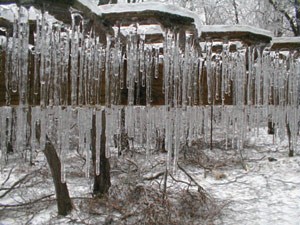
On December 11 and 12, 2008, a major ice storm coated trees in New England and upstate New York with layers of limb-snapping ice. While official tree damage estimates have yet to be released, it is safe to say that hundreds of thousands of trees were damaged. Woodland owners across the affected region may find themselves staring at a woodlot full of fallen branches and shattered tree crowns wondering whether their trees are going to die.
The short answer is no.
Research conducted by Kevin T. Smith and Walter C. Shortle after the region’s last major ice storm in January 1998 indicates that most damaged trees will survive this event, at least in the short term. Their work underscores recommendations from the U.S. Forest Service that say, in most cases, hurried salvage cuts after ice storms may not be necessary.
Smith and Shortle, scientists with the Forest Service’s Northern Research Station, began their research immediately following the 1998 ice storm, a brutal three-day event that damaged 25 million acres of forest. They tagged and tracked 516 trees, ranging in diameter from 9 to 18 inches, from six different locations within the storm footprint. Those that had lost more than half of their crowns in the storm were labeled “high-injury,” and those with less than 50 percent crow damage were called “low-injury.”
In October 1998, one growing season after the storm, the researchers deliberately reinjured the trees by drilling 3/8- inch holes 2 inches deep into the trunks to study the trees’ ability to respond to this new stress. Over the next five years, they tracked tree survival rates, growth rates, borehole closure speed, and the internal spread of infection.
The research yielded reassuring results. After five years, all low-injury trees in the study block survived. Among the highinjury trees, 100 percent of white ash and red maple survived. Ninety-nine percent of sugar maples, 97 percent of American beech, 90 percent of yellow birch and 55 percent of the paper birch survived. (The dead paper birch trees in the study block were all battling advanced rootrot disease before the storm hit; Shortle suspects that this pre-existing condition, coupled with the stress of the storm, led to the elevated mortality rates.)
After three years, there was no annual growth reduction in low-injury trees. Growth reduction in high-injury trees was pegged at 20 percent in ash, 50 percent in maple, beech, and yellow birch, and 70 percent in paper birch. The ash proved to be amazingly vigorous; ash trees that lost most or all of their branches were able to produce sprouts six feet or longer, and an inch or more in diameter, during the first summer after the storm.
The ash trees also responded best to the borehole injuries, with both low- and high-injury trees showing significant hole closure after one year and complete closure after three years. Paper birch responded poorly to the boreholes (no closure after three years). The maple, beech, and birch did close the bored holes, but more slowly than the ash.
The take home message is that if a tree was healthy and its roots vigorous before the storm, a landowner can assume that it will begin to recover. While the strain from ice damage, coupled with other negative factors, may eventually kill a highinjury tree, in most cases, this process will play out over a decade or more. This doesn’t make the loss any more palatable, but it does give foresters and landowners more time to make decisions about salvaging damaged trees.
“Many people were predicting after the last storm that if you didn’t harvest right off, you’d risk losing timber value, but we found that even badly damaged trees were able to compartmentalize above the commercially valuable part of the trunk,” said Shortle.
Shortle adds that more research needs to be done to determine the long-term effects of the 1998 ice storm. Anecdotal evidence suggests that after 10 years, many mature, high-injury trees are showing signs of decline. Shortle and Smith are seeking funding to continue their work.

